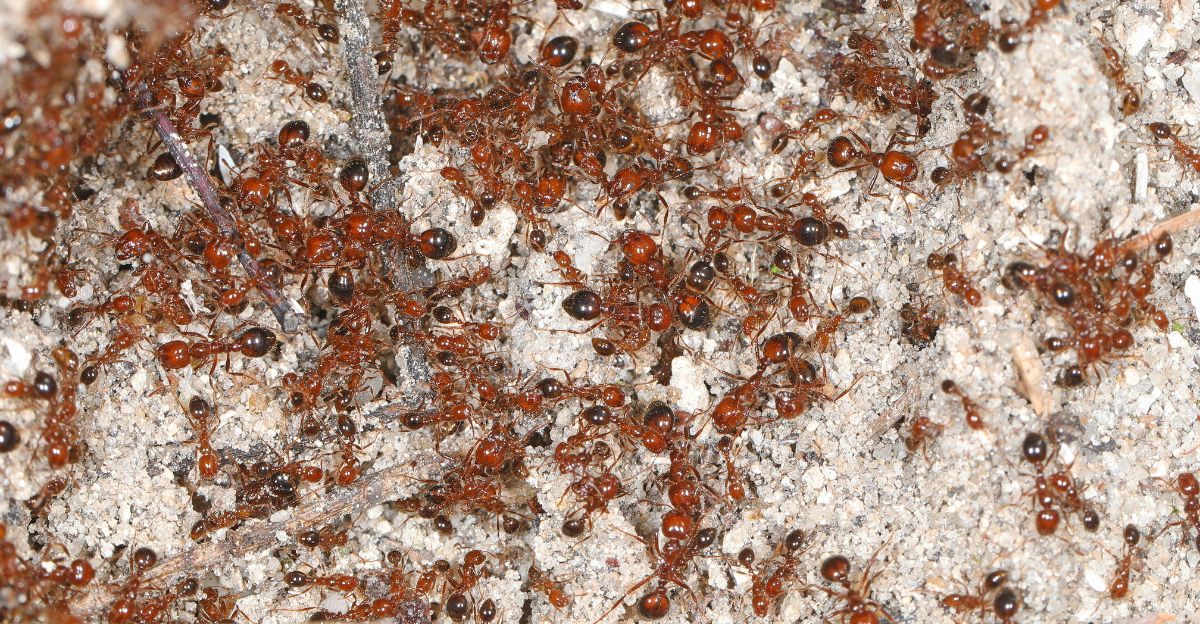
Imported fire ants are pests known for their extremely painful stings and aggressive behavior. Unfortunately, they are quickly spreading across Virginia. These invasive insects were once limited to the Southeast, but they are now being reported in new counties, alarming residents and experts.
Their spread isn’t just an annoyance; it is triggering a chain reaction of consequences for homeowners, businesses, farmers, and the state’s economy. As these ants spread, Virginia is facing a problem that could soon ripple far beyond the state’s borders.
Why It’s Happening

So why is this happening? Well, warmer winters, more rainfall, and the accidental movement of soil or plants infested with these insects are fueling the fire ant invasion. Hybrid fire ants, which are far more cold-tolerant than their southern cousins, are thriving in Virginia’s shifting climate.
Unfortunately, human activity, like moving nursery stock and sod, also contributes to these ants establishing new colonies, making containment even harder and accelerating their spread into previously unaffected regions.
Changes at Home and in Neighborhoods

Recently, residents have reported seeing more fire ant mounds in their yards, at parks, and on playgrounds. These pests’ painful stings are becoming a massive risk for children and pets, forcing families to invest in pest control.
In some neighborhoods, residents might face restrictions on moving soil or outdoor equipment to prevent these ants from spreading any further, which could change how people care for their lawns and interact with their outdoor spaces.
Impact on Local Businesses

Businesses like landscapers, nurseries, and sod farms in quarantine areas must now prove that their products are free of fire ants before they can be shipped. This adds extra costs and paperwork, with the threat of fines or lost business for businesses that fail to comply with these changes.
Some might even have to invest in new treatments or change their operations, which could have a huge impact on jobs and local economies as the ants continue to expand.
Threats to Agriculture

Farms are also feeling the impact as these fire ants damage their crops, chew through irrigation systems, and even attack livestock, especially newborn animals. These pests are truly problematic on farms as they can lower yields and raise costs for veterinary care and pest management.
This could result in higher prices for local produce and meat. It could also pose new challenges for farmers who are already struggling with unpredictable weather and market pressures.
Wildlife and Ecosystem Disruption

But fire ants don’t just affect people; they are known to disrupt entire ecosystems. These ants reduce biodiversity by outcompeting native ants, as well as feeding on ground-nesting birds, reptiles, and beneficial insects.
Their aggressive foraging disrupts food webs and upsets the balance of local habitats, posing long-term risks to rural and urban wildlife throughout Virginia.
Public Health Concerns

Fire ant stings are not to be taken lightly. They can cause severe allergic reactions, including anaphylactic shock in some individuals. With these ants spreading, hospitals might soon see more cases, especially among children, the elderly, and people with allergies.
The psychological impact, like fear of outdoor activities and increased anxiety, can also affect the quality of life for thousands, if not millions, of Americans, turning public health into yet another victim of the ants’ relentless spread.
Unexpected Medical Side Effects

However, on an interesting note, the spread of these fire ants could be reducing the spread of tick-borne meat allergies, like alpha-gal syndrome, by feeding on ticks. But this comes at a cost: more allergic reactions to ant stings.
It’s a trade-off, with one health risk decreasing while another rises. This just shows how invasive species can change the landscape of medical concerns in surprising ways.
Global and Regional Trade Impacts

The quarantine impacts not only local trade but also regional and international markets. Virginia’s hay, sod, and nursery plants are now facing added restrictions or inspections in other states and countries.
This can disrupt exports, drive up costs, and harm the reputation of Virginia’s agriculture, creating ripple effects for producers and consumers far beyond the state.
Policy and Government Response

State and federal officials are working hard to ramp up efforts to contain these ants. They are expanding quarantine zones, funding research into better pest control methods, and launching public education campaigns to warn people of these ants.
Lawmakers are also thinking about emergency subsidies for impacted farmers and businesses, acknowledging that without strong intervention, the fire ant threat can soon spread beyond state borders.
What to Do Now

But what can we do now? Residents should report any suspected fire ant mounds, avoid disturbing them, and use approved baits or mound treatments. At the same time, businesses should follow quarantine rules closely and ensure that products are free of any ants before shipping them.
Staying informed and vigilant about this ant problem is super important for everyone. By taking action now, we can help slow the spread and protect property and health.
Their Impact

What first started as a few random mounds here and there now threatens to reshape Virginia’s landscapes, economies, and the daily lives of its citizens.
As imported fire ants continue to spread into new areas, their impact will be felt in many different ways, reminding us that even the smallest invaders can cause ripple effects that affect us all.
Explore more of our trending stories and hit Follow to keep them coming to your feed!

Don’t miss out on more stories like this! Hit the Follow button at the top of this article to stay updated with the latest news. Share your thoughts in the comments—we’d love to hear from you!







